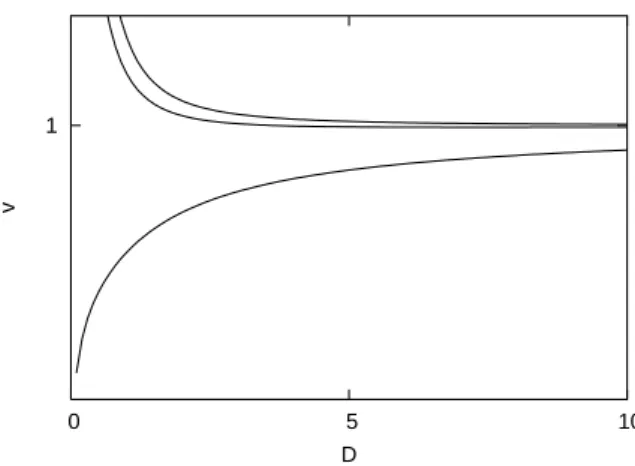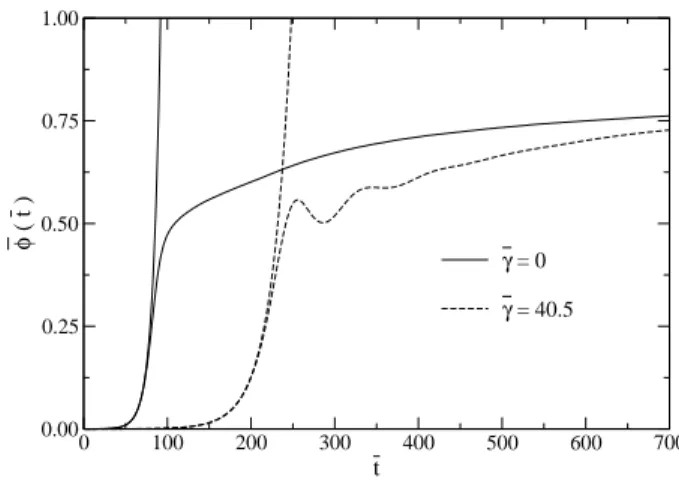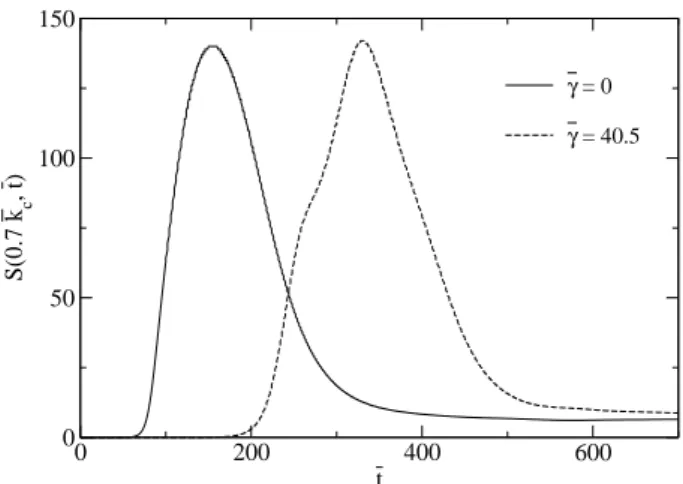Brazilian Journal of Physics, vol. 37, no. 2B, June, 2007 601
Memory Effect and Fast Spinodal Decomposition
T. Koide,
Instituto de F´ısica, Universidade Federal do Rio de Janeiro, 68528, 21941-972, Rio de Janeiro, RJ, Brazil
G. Krein,
Instituto de F´ısica Te´orica, Universidade Estadual Paulista, 01405-900 S ˜ao Paulo, SP, Brazil
and Rudnei O. Ramos
Departamento de F´ısica Te´orica, Universidade do Estado do Rio de Janeiro, 20550-013 Rio de Janeiro, RJ, Brazil
Received on 21 September, 2006
We consider the modification of the Cahn-Hilliard equation when a time delay process through a memory function is taken into account. We then study the process of spinodal decomposition in fast phase transitions associated with a conserved order parameter. The introduced memory effect plays an important role to obtain a finite group velocity. Then, we discuss the constraint for the parameters to satisfy causality. The memory effect is seen to affect the dynamics of phase transition at short times and have the effect of delaying, in a significant way, the process of rapid growth of the order parameter that follows a quench into the spinodal region. Keywords: Non-equilibrium field dynamics; Memory effects; Relativistic heavy-ion collisions
I. BACKGROUND
Diffusion is a typical relaxation process and appears in var-ious fields of physics: thermal diffusion processes, spin dif-fusion processes, Brownian motions and so on. It is empiri-cally known that the dynamics of these processes is approx-imately given by the diffusion equation. Although the diffu-sion equation has broad applicability, there exist the applica-bility limitations. First, the diffusion equation does not obey causality[1]. Let us consider the following telegraph equation,
τd 2
dt2m(x,t) + d
dtn(x,t)−D∇
2n(x,t) =
0. (1)
Then, the propagation speed is given byv=p
D/τ. Thus, the propagation speed of the diffusion equation is infinite because the telegraph equation is reduced to the diffusion equation in the limit of vanishingτ. Second, the diffusion equation does not satisfy exact relations, for instance, the Kramers-Kronig relation and the f-sum rule [2, 3]. By solving the Heisenberg equation of motion, the exact Laplace-Fourier transform of the time-evolution of a conserved number density is given by
δnLF(k,z) =i zC(k) +
i z3
k2
mhn(0)ieq+O(1/z
4), (2)
whereδmeans the fluctuations from the equilibrium value and C(k)represents the Fourier transform of the correlation func-tion of the number density. Because of the Kramers-Kronig relation and the f-sum rule, the term proportional to 1/z2 disappears and the coefficient of the second term is propor-tional to the equilibrium expectation value of the total number
hn(0)ieq. These are not satisfied if the coarse-grained dynam-ics of the number density is assumed to be given by the diffu-sion equation [2, 3].
It is known that the problem of causality and the sum rules can be solved by using the telegraph equation instead of the diffusion equation. Interestingly enough, it has been shown
recently that the coarse-grained equation derived by employ-ing systematic coarse-grainemploy-ings from the Heisenberg equation of motion is not the diffusion equation but the telegraph equa-tion [3, 4].
The discussion so far is applicable to conserved quanti-ties because the diffusion equation is a coarse-grained equa-tion of conserved quantities. On the other hand, the corre-sponding equation for a non-conserved quantity is the time-dependent Ginzburg-Landau (TDGL) equation in the sense that the TDGL equation is a overdamping equation. The mi-croscopic calculation [7] again shows that the relaxation phe-nomenon is accompanied by oscillation and cannot be de-scribed by the TDGL equation as is the case with conserved quantities. As a matter of fact, the equation has a similar form to the telegraph equation.
602 T. Koide, G. Krein, and Rudnei O. Ramos
II. MEMORY EFFECT IN SPINODAL DECOMPOSITION
So far, we have discussed the difficulties with causality and memory effects, and sum rules associated with linear processes. Next, we consider such problems associated with a nonlinear process, known as spinodal decomposition(SD) [8]. We consider the general Ginzburg-Landau (GL) Free en-ergy,
F(φ) =
Z
d3x ·a
2(∇φ) 2−b
2φ 2+c
4φ 4
¸
, (3)
whereφis a conserved order parameter. To describe the phase transition, the parameterb is proportional toTc−T withTc being the critical temperature of the associated second order phase transition. The dynamics of conserved order parameters can be described by the Cahn-Hilliard (CH) equation. In the ordinary CH equation, the irreversible current induced by the GL free energy is given by
J(x,t) =−Γ∇δF(φ)
δφ , (4)
whereΓdenotes a kind of Onsager coefficient. To take the memory effect into account, the current is generalized as fol-lows,
J(x,t) =−
Z t
0
dsd3x′
M
(x−x′,t−s)∇x′ δF(φ)δφ(x′,s). (5) For simplicity, we assume the following memory function,
M
(x,t) =Γ γe−t/γδ(3)(x). (6)
Here, the typical memory time is characterized byγ. Substi-tuting the current to the equation of continuity, we obtain the modified CH equation,
γ∂ 2
∂t2φ(x,t) + ∂
∂tφ(x,t) =Γ∇ 2δF(φ)
δφ . (7)
At the late stage of the spinodal decomposition, the be-havior of the process is described by the linearized equation around equilibrium order parameterφ0=
p
b/a,
γ∂ 2
∂t2φ˜c(k,t) + ∂
∂tφ˜c(k,t) =−Γk 2(ak2+
2b)φ˜c(k,t), (8) whose solution is ˜φc(k,t) =Akexp(λ′+t) +Bkexp(λ′−t), where AkandBkare arbitrary constants and
λ′±=−1±
p
1−4γΓk2(ak2+2b)
2γ . (9)
On the other hand, the solution for the corresponding ordinary CH equation (γ=0) is ˜φnc(k,t) =Ckexp[−Γk2(2b+ak2)t]. One can easily see that there exists a critical momentum for the solution of the modified CH equation, k′2c = [−b+
p
b2+a/(4γΓ)]/a. Below the critical momentum, the solu-tion shows overdamping behavior similar to the ordinary CH
1
0 5 10
v
D
FIG. 1: The group velocity (11) as function ofDfor a fixed value ξ=1. The three lines are corresponding toγ=D,D+0.1 andD+1, respectively.
solution, while above the critical momentum, the damping is accompanied by the oscillatory fluctuation mode. Thus, we can consider that the critical momentum is a kind of a ultra-violet cutoff because the higher momentum modes have rapid oscillations and cancel in computing averages. The propa-gation speed is characterized by the group velocity. In the modified CH equation, this is given by
v(k) =
√
2D(ξ2k2+1)
p
γ(ξ2k2+2) , (10)
whereD=2bΓandξ=pa/b. Atk=0, the group veloc-ity readsv(0) =p
D/γ. The maximum group velocity is a monotonically increase function ofk. Because of the momen-tum cutoff discussed above, the maximum group velocity is given by
v(k′c) = 2D
γ
1+ξ2/(2γD) 1+p
1+ξ2/(2γD). (11) For causality, Eq. (11) should be less than one. This leads to the constraintγ>D. In other words, we can always find allowed values of parameters for which the spinodal decom-position is causal, under the constraint. In Fig. 1, the group velocity is plotted as function ofDfor a fixed valueξ=1. The three lines corresponds toγ=D,D+0.1 andD+1, re-spectively. One can see that the group velocity is larger than one for anyDatγ=D. Atγ=D+0.1, one can findDwhere the group velocity is less than one. Atγ=D+1, the group velocity is less than one for anyD. The modified CH equation satisfies causality in this sense.
Brazilian Journal of Physics, vol. 37, no. 2B, June, 2007 603
by
∂ ∂k
−1+λ 2γ
¯ ¯ ¯ ¯k
r
=0, (12)
we derive the time scale of the fastest mode to be
τc(kr) = 2γ
−1+p
1+γD/(2ξ2). (13) Whenγis very small, the time scale is reduced toτnc(kr) = 8ξ2/D, which agrees with the time scale of the SD without the effect of memory [9]. Since the modes that give the result of Eq. (13) are in fact the dominant spinodal modes andτnc<τc, this reflects itself in an overall delay of the time formation of domains, as described by the causal CH equation compared to the noncausal one, as the phase transition proceeds. This fea-ture is confirmed by our simulations shown below. For a prob-lem like RHIC and a possible signature of a phase transition coming from it, this difference in time scales can be very pro-nounced and lead to a striking effect that a signal, like charge fluctuations and domain formation, can be so much delayed that possibly could not be observed in the current experiments. For instance, in RHIC, the correlation length is typicallyξ∼1 fm. Using also the relation between the parametersDandγ obtained for a quark plasma,γ=3D, which is consistent with our constraint condition obtained from Eq. (11), and consider-ingD∼3.7 fm [9, 10], we obtain from Eq. (13) thatτc∼6.1 fm, which is to be compared with the resultτnc∼2.2 fm. This represents almost a 200% difference for the time scales for the starting of the growth of fluctuations in Eq. (7) as compared to the ordinary CH equation (forγ=0).
We have solved Eq. (7) numerically on a discrete spatial square lattice using a semi-implicit scheme in time, with a fast Fourier transform in the spatial coordinates [8]. We have checked the stability of the results by changing lattice spac-ings and time steps. In addition, forγ>1 we have also used a leap-frog algorithm and the results obtained with both meth-ods agreed very well. For the noncausalγ=0 equation, we used as initial conditionφ(x,t =0)a random distribution in space with zero average and amplitude 10−3. Forγ6=0, we used in addition the condition that at t =0 the first-order derivative of φ is zero. For the numerical work, Eq. (7) is re-parameterized to dimensionless variables, conveniently defined by time ¯t= (8/τnc)t= (2b2Γ/a)t, space coordinates
¯
xi=xi/ξ, field ¯φ=
p
c/bφand ¯γ= (8/τnc)γ. In terms of these variables Eq. (7) becomes function of only one parameter, ¯γ. Eq. (7) was next solved for several values of ¯γ. Two rep-resentatives results, for ¯γ=0 and ¯γ=40.5 (for the example analyzed in the previous paragraph), are shown in Fig. 2.
In Fig. 2 we present the time evolution of the vol-ume average of the order parameter φ, defined as ¯φ(t) =
1
N3∑xhφ¯(x,t)+i, whereN3is the total number of lattice points and the average is taken over different initial random configu-rations. φ(x,t)+indicates that only the positive values of the field are considered (i.e., a specific direction for the field has been selected). The rapid increase of ¯φreflects the phenom-enon of SD. The figure also shows the results by solving the linear equation. It shows that it performs extremely well up
0 100 200 300 400 500 600 700
t
0.00 0.25 0.50 0.75 1.00
φ
(
t )
γ = 0
γ = 40.5
FIG. 2: Volume average of ¯φ(t¯)as a function of dimensionless time ¯
t for the noncausal (solid) and causal (dashed) solutions. The two curves that exit the top of the plot are results from the linearized theory.
to and right after the spinodal growth of the order parameter, then justifying our previous analytical results based on the so-lution of the linear equation. The effect ofγis seen to be more important at earlier times, consistent with the memory func-tion used and becomes less important after the rapid growth of the order parameter (the spinodal explosion). It also shows the effect of a finiteγ, increasing dramatically the delay of the spinodal explosion, as predicted by our previous analytical re-sults. The time for reaching equilibrium is seen to be very long, as is common with the traditional noncausal CH equa-tion. Also apparent from Fig. 2 are the oscillations in the order parameter for a finiteγ, also predicted by our previous analy-sis. This is due to the increasing importance of the second-order time derivative as compared to the first-second-order one asγ increases, i.e. asγincreases the dissipation term becomes less important and the equation becomes more and more a wave-like equation. The estimated delay for the thermalization is even larger than the recent estimation [11] for the time delay of the relaxation of a nonconserved order parameter.
We have also investigated the effect of memory for the structure function,S(k,t) =|φ(k,t)|2. This quantity is impor-tant because it provides information on the space-time coars-ening of the domains of the different phases. In Fig. 3 we present the results for the spherically averaged value ofSfor k=0.7kc (to emphasize the fast growth of the long wave-length fluctuations withk<kc). The spherical averaging for a givenkwas done over momentakr=
q
k2
x+k2y+k2z such that k−0.1∆≤kr≤k+0.1∆, with∆=2π/L, whereLis the size of the lattice. Consistently with Fig. 2, this figure shows the dramatic delay for the spinodal growth.
III. CONCLUSION
604 T. Koide, G. Krein, and Rudnei O. Ramos
0 200 400 600
t 0
50 100 150
S(0.7
kc
,
t)
γ = 0
γ = 40.5
FIG. 3: Spherically averaged structure function as a function of di-mensionless time ¯tfor a ¯k=0.7¯kcfor the noncausal (solid) and causal
(dashed) solutions.
velocity and, to satisfy causality, we were able to derive the constraint for the parameters of the CH equation. For a phys-ical situation of interest for the phenomenology of RHIC, we found that the inclusion of memory effects can delay substan-tially the phase-separation process and consequently, there might not be enough time for the system to thermalize before the breakdown of the system due to expansion.
In this paper, we simply discussed the case of a mem-ory function which has the exponential form. However, we can generalize the present work by considering other types of memory functions. In particular, microscopic calculations
from nonequilibrium quantum field theory [5] show that mem-ory functions tend to exihibt relaxation as well oscillations as time goes on. Then, we can consider the following physically motivated from those field theory calculations,
M
(x,t) =Γ γe−t/γcos(Ωt)δ(3)(x), (14)
whereΩis some characteristic frequency of oscillation. Sub-stituing (14) into the equation of continuity, we obtain
γ2∂3
∂t3φ(x,t) +2γ ∂2
∂t2φ(x,t) + (1+γ 2Ω2)∂
∂tφ(x,t) =Γ ∇2δF(φ)
δφ +γΓ ∂ ∂t∇
2δF(φ)
δφ . (15)
This result and the example worked out explicitly in this work shows that the macroscopic dynamics of conserved quantity strongly depends on the choice of the memory function. In these cases, the use of microscopic motivated memory func-tions based on the particular model under study is fundamen-tal. An analysis for (15), analogous to the one performed in this work for the simplest exponential decay memory func-tion, will be presented elsewhere.
Acknowledgments
The authors would like to thank CNPq, FAPERJ and FAPESP for the financial support.
[1] D. Jou, J. Casas-V´azquez, and G. Leben, Rep. Prog. Phys.51, 1105 (1988);ibid.62, 1035 (1999).
[2] L.P. Kadanoff and P.C. Martin, Ann. Phys. (N.Y.) 24, 419 (1963).
[3] T. Koide, Phys. Rev. E 72, 026135 (2005).
[4] This microscopic calculation further make it appear that the re-laxation timeτcontained in the telegraph equation is not con-stant and has momentum dependence.
[5] M. Gleiser and R.O. Ramos, Phys. Rev. D50, 2441 (1994); A. Berera and R.O.R amos, Phys. Rev. D63, 103509 (2001); Phys.
Lett. B607, 1 (2005); Phys. Rev. D71, 023513 (2005). [6] Y. Hama, T. Kodama, and O. Socolowski Jr., Braz. J. Phys.35,
24 (2005).
[7] T. Koide and M. Maruyama, Nucl. Phys. A742, 95 (2004). [8] T. Koide, G. Krein, and Rudnei. O. Ramos, Phys. Lett. B636,
96 (2006).


